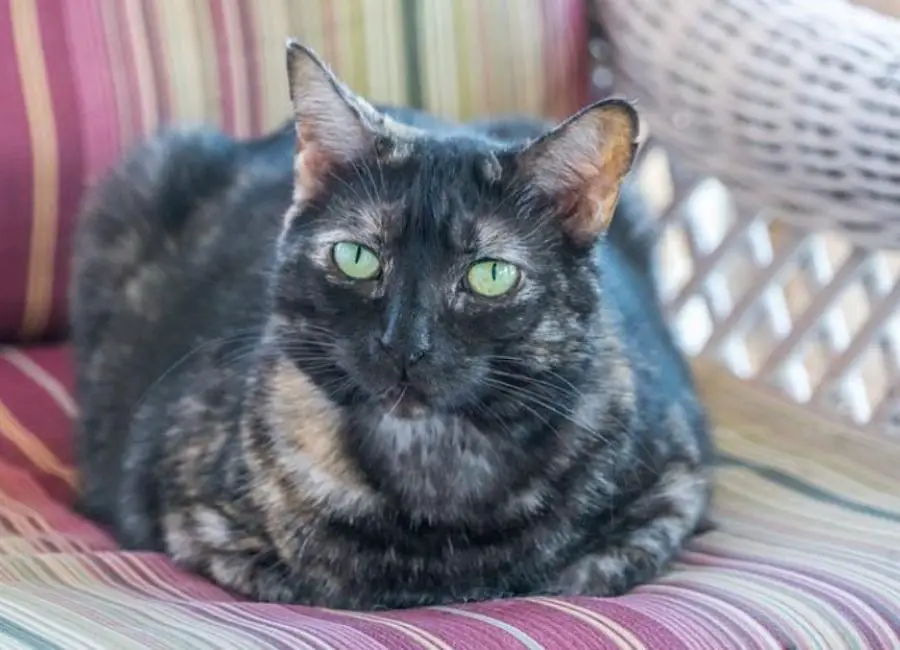Do Tortoiseshell Cats Get Along With Other Cats?

Are you considering adopting a tortoiseshell cat but unsure if they’ll get along with your other feline friends?
It’s a common question, and we’re here to shed some light on this topic.
Tortoiseshell cats are known for their unique personality traits, so it’s worth exploring how they interact with other cats to make the best decision for your home.
Keep reading to find out if tortoiseshell cats get along with other cats and what you can do to make introductions between cats smoother.
Do Tortoiseshell Cats Get Along With Other Cats
Tortoiseshell cats are generally friendly and affectionate towards other cats and people, they get along well with other cats when well-trained.
While they may have favorites and be choosy about who they show affection to, they are known to get along well with other cats.
There is no evidence to suggest that their coat color affects their ability to get along with other cats.
However, it is important to introduce cats to each other slowly and carefully to ensure a positive relationship.
Factors that Affect a Tortoiseshell Cat’s Compatibility with Other Cats
The following are some common factors that affect a Tortoiseshell Cat’s compatibility with other cats:
- Age: Cats of similar ages may be more likely to get along than cats with a large age difference.
- Gender: Male and female cats may have different social dynamics, which can affect compatibility.
- Spay/neuter status: Spayed/neutered cats may be less territorial and aggressive than unaltered cats.
- Socialization: Cats that were socialized with other cats as kittens may be more comfortable around other cats.
- Personality: Some cats are more outgoing and social, while others prefer to be alone. Compatibility can depend on the individual personalities of each cat.
- Territorial behavior: Some cats are more territorial and may not tolerate other cats in their space.
- Health issues: Cats with health issues may be more irritable and less tolerant of other cats.
- Changes in routine: Changes in routine or environment can cause stress in cats and affect their ability to get along with other cats.
- Introductions: Introducing cats to each other slowly and gradually can increase the likelihood of them getting along.
- Litter Mates: Cats that are raised together from a young age are more likely to be compatible with each other.
- Training and Positive Reinforcement: Positive reinforcement training can help cats learn to associate each other with positive experiences, which can increase their compatibility.
Tips for Introducing Tortoiseshell Cats to Other Cats
Here is the step-by-step process for introducing Tortoiseshell cats to other cats:
Step 1: Prepare a separate space for your new cat
It’s crucial to set up a separate area where your new cat can feel comfortable and secure before bringing it home.
This might be a bathroom, a guest room, or any other area of your house that your tortoiseshell cat can’t enter.
Ensure that this area contains everything your new cat will require, including food, drink, a litter box, and a cozy bed.
Step 2: Let your new cat adjust to her new surroundings
Give your new cat some time to become acquainted with her surroundings and your home’s sounds and smells.
It can require a few days, but it’s crucial to allow her to proceed at her own pace.
To make her feel more at ease and secure, you can spend time with her in her own room.
Step 3: Exchange scents between cats
It’s crucial to share scent between your tortoiseshell cat and your other cats because cats rely extensively on smell to recognize one another.
Swapping toys, bedding, or even rubbing a piece of cloth on one cat’s cheek and then providing it to the other cat to sniff will accomplish this.
This will help the cats get used to each other’s scent and make the introduction process easier.
Step 4: Allow the cats to see each other through a barrier
Use a baby gate to keep your tortoiseshell cat and your other cats apart until you’re ready to introduce them.
The cats will be able to see one another as a result, but they won’t be able to contact or hurt one another.
The cats can become used to each other’s presence without feeling intimidated during this key stage of introduction.
Step 5: Gradually increase supervised interactions
You can begin to progressively increase supervised encounters after your cats are at peace with seeing each other over a barrier.
This can entail briefly opening the door to your tortoiseshell cat’s own room while you keep an eye on the other cats.
Offer rewards and compliments to promote positive interactions.
Learn more about adopted stray cat behaviors.
Step 6: Monitor interactions and intervene if necessary
It’s crucial to keep a close eye on their interactions as you gradually introduce your new cat to your tortoiseshell cats and step in if required.
If they act aggressively or territorially, this can entail separating them.
Keep in mind to give snacks and praise as rewards for good behavior.
Learn more about cats biting other cats.
Step 7: Be patient and give it time
It’s crucial to be patient and give the process of introducing cats to one another time because it can be a slow one.
It’s vital to go at your cat’s pace because some cats may take longer to acclimate than others.
You may encourage your tortoiseshell cat and other cats to build friendly relationships and live in harmony in your home by being patient and using the right introduction strategies.
Learn more about new cat hiding and not eating.
Precautions to take when introducing Tortoiseshell cats to other cats
Here are some common precautions to take when introducing Tortoiseshell cats to other cats:
- Keep them separate at first: It’s important to keep them separate for a few days or even up to a week to allow the new cat to settle in and feel comfortable.
- Gradual introduction: When introducing the cats, make sure it’s a gradual process. Gradually introduce them to each other by letting them see, hear, and smell each other through a closed door.
- Observe their behavior: After the initial meeting, let them interact while they are supervised. Observe their behavior and be prepared to intervene if necessary. Look for body language that may indicate aggression or fear.
- Provide hiding places: Provide hiding places for both cats, such as boxes or cat beds, to allow them to retreat if they feel threatened.
- Individual feeding: Feed the cats separately to avoid competition or aggression.
- Provide individual litter boxes: Provide individual litter boxes for each cat to avoid territorial disputes.
- Distraction: Provide toys and other sources of distraction to keep the cats entertained and focused on something besides each other.
- Separate sleeping arrangements: Initially, keep the cats separate at night and provide separate sleeping arrangements.
- Patience: Take your time and be patient. It can take several weeks or even months for the cats to become comfortable around each other.
Learn more about the pros and cons of getting a second cat.
Frequently Asked Questions
Do Tortoiseshell Cats have a specific personality that makes them more or less likely to get along with other cats?
Like any other breed, Tortoiseshell Cats have their own unique personality traits that can influence their compatibility with other cats.
Some Tortoiseshell Cats are known to be more social and outgoing, while others may be more reserved or independent.
Are Tortoiseshell Cats prone to territorial behavior that might affect their willingness to coexist with other cats?
While some Tortoiseshell Cats may be territorial, this behavior is not specific to their breed.
Many other factors can influence a cat’s territorial behavior, including their age, sex, past experiences, and living environment.
Can Tortoiseshell Cats learn to coexist with other cats if they haven’t lived with other felines before?
Yes, Tortoiseshell Cats can learn to coexist with other cats if they are introduced properly and given time to adjust to one another.
It’s important to introduce cats gradually and provide them with separate resources to avoid competition and conflict.
Should I consider getting a Tortoiseshell Cat if I already have other cats in the house?
If you’re considering getting a Tortoiseshell Cat and already have other cats in the house, it’s important to consider your current cat’s personality traits and how the new cat may fit in.
It’s also important to provide them with separate resources and introduce them gradually to reduce the risk of conflict.
Are there any specific behavior signs that indicate whether Tortoiseshell Cats are likely to get along with other cats?
There’s no universal behavior sign that indicates whether Tortoiseshell Cats are likely to get along with other cats.
However, observing their body language, reaction to other cats’ scent, and general ability to socialize can give you an indication of how they might interact with other felines.
What if my Tortoiseshell Cat doesn’t get along with my other cats?
If your Tortoiseshell Cat doesn’t get along with your other cats, it’s important to intervene early to prevent the situation from escalating.
Provide your cats with separate resources, such as food, water, litter boxes, and play areas, and consider consulting an animal behaviorist.
Learn more about cats licking each other.
Conclusion
In conclusion, tortoiseshell cats can get along with other cats just fine.
While they may have a reputation for being feisty, their personalities are as unique as any other cats.
With proper introductions and socialization, tortoiseshell cats can form strong bonds with their feline companions.
So if you’re considering adding a tortoiseshell cat to your family, don’t let their reputation scare you off.





![Are Beagles Good With Cats [What You Should Know] Are Beagles Good With Cats](https://petcreeks.com/wp-content/uploads/2021/04/Are-Beagles-Good-With-Cats.jpg)
